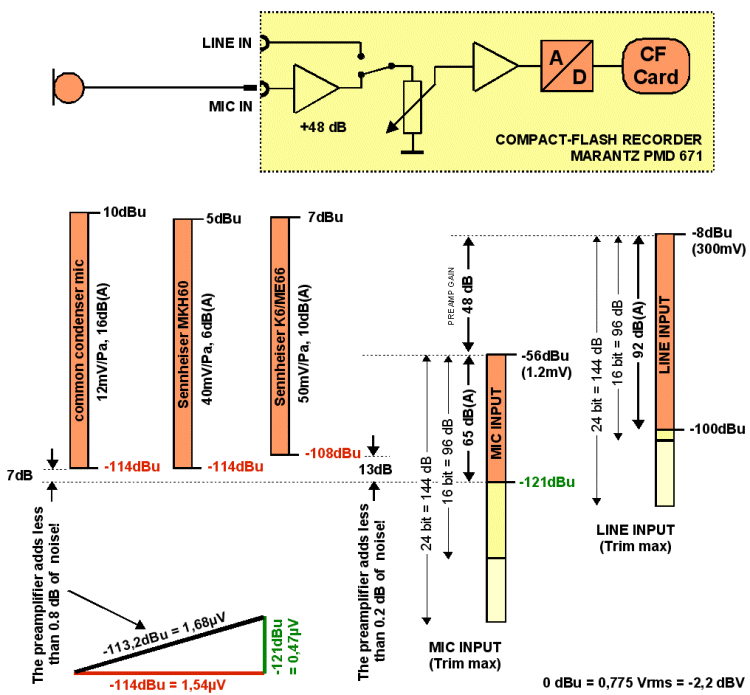Understanding microphone and recorder/preamplifier noise specifications
The specifications provided by the recorder manufacturers are often difficult to interpret. Due to marketing considerations, many manufacturers tend to publish large dynamic range numbers (e.g. > 100 dB) that are only valid for high-level signals.
The dynamic range is the ratio between the maximum (full-scale) signal level (at a certain gain setting) and the inherent noise floor of the recorder. Therefore, this figure depends on the device-specific input headroom (the level at which the preamplifier or A/D converter will be saturated) that is usually of little importance for recording soft animal sounds. In other words, the dynamic range does not necessarily tell anything about the noise performance of the recorder.
For instance, the microphone input of the Marantz PMD671 is honestly specified with a “poor” signal-to-noise ratio of 65dB(A), while the M-Audio MicroTrack claims a dynamic range of 100dB(A). However, a practical side by side test reveals that the PMD671 provides a significantly lower inherent noise level than the MicroTrack2496!
An appropriate measure for evaluating the inherent noise level of the preamplifier is the input-referenced noise level specified in dBu or dBV. Unfortunately, this figure is specified only by a few manufacturers.
The overall inherent noise floor of the entire recording system results from the combination of the inherent noise floors of both the microphone and the recorder. It is important to note that both noise components add geometrically (RMS). This means that even an extremely low noise (and expensive) preamplifier would not be able to reduce the overall noise floor. It is sufficient that the preamplifier noise level is just a few dB’s below that of the microphone. A sensitive microphone (e.g. 50 mV/Pa) provides a noise voltage level that is 20 dB higher than an insensitive (5 mV/Pa) microphone. In other words, such a sensitive microphone could be considered as a combination of an insensitive microphone (5mV/Pa) and a “zero noise” preamplifier (assuming that the microphones have identical equivalent noise level specifications (e.g. 10 dB(A)).
Consequently, there is no relevant noise added by virtually any professional recorder as long as a sufficiently sensitive (hot) microphone is being used. However, a less sensitive microphone (e.g. a dynamic microphone having a sensitivity below 2 mV/Pa) would be more demanding.
More detailed information on how to select appropriate mic preamps can be found at RANE. A comparison of the input noise properties of a few portable recorders can be found on the page Microphone Input Noise Comparision.
The graph below depicts the noise level relations between various microphone models and a common professional audio recorder (based on specifications published by Sennheiser and Marantz and the look-up tables by RANE, and verified in practical tests).

Besides the fact that there is no reason to worry about the Marantz PMD671 preamplifier noise, it turns out that the optionally available 24 bit recording format cannot provide any significant improvement of the noise performance.
